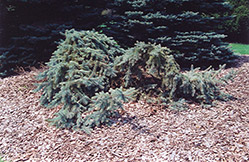Johnson Brothers Plant Finder
Creeping Blue Spruce
Picea pungens 'Glauca Prostrata'
Height: 24 inches
Spread: 10 feet
Sunlight:
![]()
![]()
Hardiness Zone: 2b
Other Names: Glauca Procumbens
Description:
A spreading and trailing shrub, very unlike the species; features dusty blue pointy needles, tends to crawl along the ground and over rocks or walls; durable and hardy, an excellent choice for detail use in the garden
Ornamental Features
Creeping Blue Spruce is a dwarf conifer which is primarily valued in the garden for its broadly spreading habit of growth. It has attractive blue evergreen foliage which emerges silvery blue in spring. The needles are highly ornamental and remain blue throughout the winter.
Landscape Attributes
Creeping Blue Spruce is a dense multi-stemmed evergreen shrub with a ground-hugging habit of growth. Its relatively fine texture sets it apart from other landscape plants with less refined foliage.
This is a relatively low maintenance shrub. When pruning is necessary, it is recommended to only trim back the new growth of the current season, other than to remove any dieback. Deer don't particularly care for this plant and will usually leave it alone in favor of tastier treats. It has no significant negative characteristics.
Creeping Blue Spruce is recommended for the following landscape applications;
- General Garden Use
- Groundcover
Planting & Growing
Creeping Blue Spruce will grow to be about 24 inches tall at maturity, with a spread of 10 feet. It tends to fill out right to the ground and therefore doesn't necessarily require facer plants in front. It grows at a slow rate, and under ideal conditions can be expected to live for 60 years or more.
This shrub does best in full sun to partial shade. It is very adaptable to both dry and moist growing conditions, but will not tolerate any standing water. It is considered to be drought-tolerant, and thus makes an ideal choice for a low-water garden or xeriscape application. It is not particular as to soil type or pH, and is able to handle environmental salt. It is highly tolerant of urban pollution and will even thrive in inner city environments. This is a selection of a native North American species.

